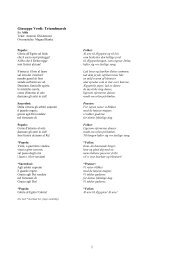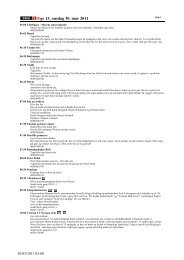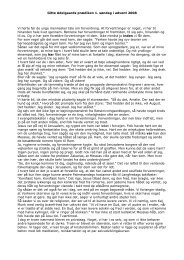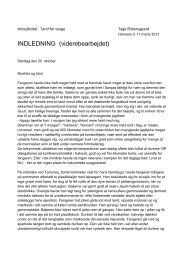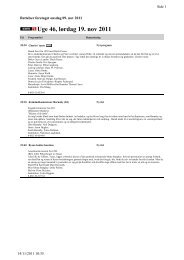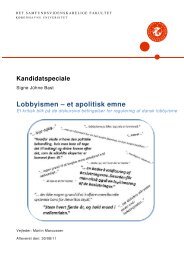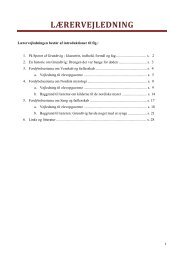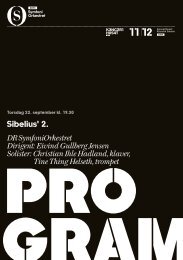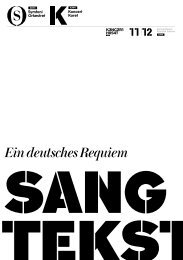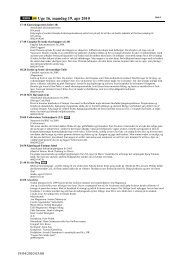Sundhedseffekter og relaterede eksterne omkostninger af ... - DR
Sundhedseffekter og relaterede eksterne omkostninger af ... - DR
Sundhedseffekter og relaterede eksterne omkostninger af ... - DR
Create successful ePaper yourself
Turn your PDF publications into a flip-book with our unique Google optimized e-Paper software.
External costs related to ozone have been calculated to about DKK 250 millions<br />
in Copenhagen metropolitan area, including about DKK 60 million for<br />
the municipalities of Copenhagen and Frederiksberg. Ozone is not directly<br />
emitted but is formed in the atmosphere from emissions of NOx, hydrocarbons<br />
and CO. Ozone is directly harmful to health, and therefore associated<br />
with external costs.<br />
Contributions from CO to external costs are very small with about DKK 4<br />
millions in Copenhagen metropolitan area including about DKK 2 million in<br />
the municipalities of Copenhagen and Frederiksberg.<br />
Most of the external costs are due to premature deaths.<br />
External costs in the Copenhagen metropolitan area related to emission<br />
sources in Copenhagen<br />
It is investigated how much the different local emission sources in Copenhagen<br />
contribute to health impacts in the Copenhagen metropolitan area.<br />
The total external costs are about DKK 600 millions in Copenhagen metropolitan<br />
area due to emissions sources in municipalities of Copenhagen and<br />
Frederiksberg in 2010. The total external costs in the Copenhagen metropolitan<br />
area due to all air pollution from domestic and foreign emissions sources<br />
are approx. DKK 12 billion and local emissions in municipalities of Copenhagen<br />
and Frederiksberg contribute only about DKK 600 million corresponding<br />
to around 5%. This comparison is not entirely justified since we<br />
only include the external costs up to 20 km from the municipal border of<br />
Copenhagen and compares this with the total external costs within Copenhagen<br />
metropolitan area where we should compare with the total external<br />
costs within 20 km. However, this is not at present possible because of the<br />
way the model is set up. 5% is therefore an underestimation.<br />
The external costs are due almost entirely to PM2.5 as the local sources only<br />
are primarily emitted PM2.5 as secondary particles are not formed on the<br />
short transport distances within the Copenhagen metropolitan area. The external<br />
costs of ozone are negative (DKK -60 million) which in this context<br />
shows that ozone counts positively. This is due to local emissions of nitr<strong>og</strong>en<br />
oxides (NOx = NO + NO2) in municipalities of Copenhagen and Frederiksberg<br />
and contribute to the reduction of O3 levels in the city (NO reacts with<br />
O3 to form NO2), and therefore there is a "positive" effect of NOx since it reduces<br />
harmful O3.<br />
External costs related to CO are negligible.<br />
The main local source in Copenhagen that contributes to the external costs in<br />
the Copenhagen metropolitan area is non-industrial combustion (which consists<br />
primarily of combustion in wood stoves and boilers) which accounts for<br />
about 2/3 of the external costs followed by road transport with 1/4. Other<br />
types of sources which give a notable contribution is the use of products<br />
(emissions from solvents and use of products) with approx. 5% and mobile<br />
sources (non-road mobile machinery, etc.) with approx. 4%.<br />
External costs in Copenhagen related to emission sources in Copenhagen<br />
Similarly, external costs for the municipalities of Copenhagen and Frederiksberg<br />
in 2010 due to local emissions in the municipalities of Copenhagen<br />
and Frederiksberg have been calculated.<br />
15




